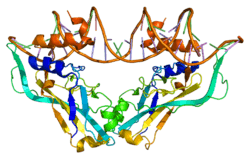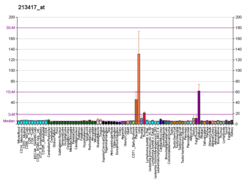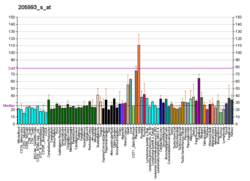TBX2
T-box transcription factor 2 Tbx2 is a transcription factor that is encoded by the Tbx2 gene on chromosome 17q21-22 in humans.[5][6][7] This gene is a member of a phylogenetically conserved family of genes that share a common DNA-binding domain, the T-box. Tbx2 and Tbx3 are the only T-box transcription factors that act as transcriptional repressors rather than transcriptional activators, and are closely related in terms of development and tumorigenesis.[8] This gene plays a significant role in embryonic and fetal development through control of gene expression, and also has implications in various cancers. Tbx2 is associated with numerous signaling pathways, BMP, TGFβ, Wnt, and FGF, which allow for patterning and proliferation during organogenesis in fetal development.[8]
Role in development
During fetal development, the relationship of Tbx2 to FGF, BMP, and Wnt signaling pathways indicates its extensive control in development of various organ systems. It functions predominantly in the patterning of organ development rather than tissue proliferation. Tbx2 has implications in limb development, atrioventricular development of the heart, and development of the anterior brain tissues.[9][10][11]
During limb bud development, Shh and FGF signaling stimulate the outgrowth of the limb. At a certain point, Tbx2 concentrations are such that the signaling of Shh and FGF are terminated, halting further progression and outgrowth of the limb development. This occurs directly through Tbx2 repressing the expression of Grem1, creating a negative Grem1 zone, thereby disrupting the outgrowth signaling by Shh and FGF.[9]
Cardiac development is heavily regulated and requires the development of the four cardiac chambers, septum, and various valve components for outflow and inflow. In heart development, Tbx2 is up-regulated by BMP2 to stimulate atrioventricular development.[10] The development of a Tbx2 knockout mouse model allowed for the determination of specific roles of Tbx2 in cardiac development, and scientists determined Tbx2 and Tbx3 to be redundant in much of heart development.[10] Further, the use of these knockout models determined the significance of Tbx2 in the BMP signaling pathway for development of the atrioventricular canal, atrioventricular nodal phenotype, and atrioventricular cushion.[10]
The atrioventricular canal signaling cascade involves the atrial natriuretic factor gene (ANF). This gene is one of the first hallmarks of chamber formation in the developing myocardium. A small fragment within this gene can repress the promoter of cardiac troponin I (cTnI) selectively in the atrioventricular canal. T-box factor and NK2-homeobox factor binding element are involved in the repression of the atrioventricular canal without affecting its chamber activity. Tbx2 forms a complex with Nkx2.5 on the ANF gene to repress its promoter activity, so that the gene's expression is inhibited in the atrioventricular canal during chamber differentiation.[12] The atrioventricular canal is also the origin of the atrioventricular nodal axis and helps eventually coordinate the beating heart. The role of Tbx2 in cushion formation in the developing heart is by working with Tbx3 to trigger a feed-forward loop with BMP2 for the coordinated development of these cushions.[10] Tbx2 has also been found to temporally suppress the proliferation and differentiation a subset of the primary myocardial cells.[13]
Finally, during anterior brain development, BMP stimulates the expression of Tbx2, which suppresses FGF signaling. This suppression of FGF signaling further represses the expression of Flrt3, which is necessary for anterior brain development.
Associated congenital defects
It is known that Tbx2 functions in a dose-dependent manner; therefore, duplication or deletion of the region encompassing Tbx2 can cause various congenital defects, including: microcephaly, various ventricular-septal defects, and skeletal abnormalities.[14][15][16] Some specific abnormalities are discussed further below.
Abnormalities of the digits
During limb bud development, down-regulation of Tbx2 fails to inhibit Shh/FGF4 signaling; therefore, resulting in increased limb bud size and duplication of the 4th digit, polydactyly.[9] Opposite this, when Tbx2 is over expressed or duplicated, limb buds are smaller and can have reduced digit number because of the early termination of Shh and FGF4 signaling.[9]
Ventricular septal defects
This is a broad category encompassing many more specific congenital heart defects. Of those related to Tbx2, some are caused by duplication, or over expression, of Tbx2, and others are caused by deletion of the Tbx2 gene region. For example, patients with a duplication of the Tbx2 gene region have presented with atrioventricular abnormalities including: interventricular septal defect, patent foramen ovale, aortic coarctation, tricuspid valve insufficiency, and mitral valve stenosis.[16] Contrary, those with Tbx2 gene deletion have presented with pulmonary hypertension and other heart defects, but is less reported.[17][15]
Role in tumorigenesis
Tbx2 has been implicated in cancers associated with the lung, breast, bone, pancreas, and melanoma. It is known to be over-expressed in this group of cancers, altering cell-signaling pathways leading to tumorigenesis. Several pathways have been suggested and studied using mouse knockout models of genes within the signaling pathways. Currently, research using the knockout model of Tbx2 for study of tumorigenesis is limited.
p14ARF/MDM2/p35/p21CIP1 Pathway. When up-regulated, Tbx2 inhibits p21CIP1. p21CIP1 is necessary for tissue senescence, and when compromised, leaves the tissue vulnerable to tumor-promoting signals.[18]
Wnt/beta-catenin Pathway. The role of Tbx2 in Wnt signaling has yet to be confirmed; however, up-regulation of Tbx2 in the beta-catenin signaling pathway leads to loss of the adhesion molecule E-cadherin.[19] This returns cells to a mesenchymal state, and facilitates invasion of tumor cells.
EGR1 Signaling Pathway. Finally, Tbx2 up-regulation increases its interaction with EGR1. EGR1 represses NDGR1 to increase cell proliferation, resulting in metastasis or tumor development.[20]
Together, the up-regulation of Tbx2 on these signaling pathways can lead to development of malignant tumors.
Cancer treatment target
Understanding the signaling pathways, and the role of Tbx2 in tumorigenesis, can aid in developing gene-targeted cancer treatments. Because Tbx2 is up-regulated in various types of cancer cells in multiple organ systems, the potential for gene therapy is optimistic. Scientists are interested in targeting a small domain of Tbx2 and Tbx3 to reduce its expression, and utilize small peptides known to suppress tumor genes to inhibit proliferation. An in vitro study using a cell line of human prostate cancer blocked endogenous Tbx2 using Tbx2 dominant-negative retroviral vectors found reduced tumor cell proliferation.[21] Further, the same study suggests targeting WNT3A because of its role in cell-signaling with Tbx2, by utilizing a WNT antagonist such as SFRP-2. Because somatic cells have low expression of Tbx2, a targeted Tbx2 gene treatment would leave healthy somatic cells unharmed, thereby providing a treatment with low toxicity and negative side effects.[8] Much research is still required to determine the efficacy of these specific gene targets to anti-cancer treatments.
References
- GRCh38: Ensembl release 89: ENSG00000121068 - Ensembl, May 2017
- GRCm38: Ensembl release 89: ENSMUSG00000000093 - Ensembl, May 2017
- "Human PubMed Reference:". National Center for Biotechnology Information, U.S. National Library of Medicine.
- "Mouse PubMed Reference:". National Center for Biotechnology Information, U.S. National Library of Medicine.
- Campbell C, Goodrich K, Casey G, Beatty B (July 1995). "Cloning and mapping of a human gene (TBX2) sharing a highly conserved protein motif with the Drosophila omb gene". Genomics. 28 (2): 255–60. doi:10.1006/geno.1995.1139. PMID 8530034.
- "Entrez Gene: TBX2 T-box 2".
- Law DJ, Gebuhr T, Garvey N, Agulnik SI, Silver LM (November 1995). "Identification, characterization, and localization to chromosome 17q21-22 of the human TBX2 homolog, member of a conserved developmental gene family". Mammalian Genome. 6 (11): 793–7. doi:10.1007/bf00539006. hdl:2027.42/47017. PMID 8597636.
- Lu J, Li XP, Dong Q, Kung HF, He ML (December 2010). "TBX2 and TBX3: the special value for anticancer drug targets". Biochimica et Biophysica Acta (BBA) - Reviews on Cancer. 1806 (2): 268–74. doi:10.1016/j.bbcan.2010.07.001. PMC 7127380. PMID 20624445.
- Farin HF, Lüdtke TH, Schmidt MK, Placzko S, Schuster-Gossler K, Petry M, Christoffels VM, Kispert A (2013-04-25). "Tbx2 terminates shh/fgf signaling in the developing mouse limb bud by direct repression of gremlin1". PLOS Genetics. 9 (4): e1003467. doi:10.1371/journal.pgen.1003467. PMC 3636256. PMID 23633963.
- Singh R, Hoogaars WM, Barnett P, Grieskamp T, Rana MS, Buermans H, Farin HF, Petry M, Heallen T, Martin JF, Moorman AF, 't Hoen PA, Kispert A, Christoffels VM (April 2012). "Tbx2 and Tbx3 induce atrioventricular myocardial development and endocardial cushion formation". Cellular and Molecular Life Sciences. 69 (8): 1377–89. doi:10.1007/s00018-011-0884-2. PMC 3314179. PMID 22130515.
- Cho GS, Park DS, Choi SC, Han JK (January 2017). "Tbx2 regulates anterior neural specification by repressing FGF signaling pathway". Developmental Biology. 421 (2): 183–193. doi:10.1016/j.ydbio.2016.11.020. PMID 27913219.
- Habets PE, Moorman AF, Clout DE, van Roon MA, Lingbeek M, van Lohuizen M, Campione M, Christoffels VM (May 2002). "Cooperative action of Tbx2 and Nkx2.5 inhibits ANF expression in the atrioventricular canal: implications for cardiac chamber formation". Genes & Development. 16 (10): 1234–46. doi:10.1101/gad.222902. PMC 186286. PMID 12023302.
- Aanhaanen WT, Brons JF, Domínguez JN, Rana MS, Norden J, Airik R, Wakker V, de Gier-de Vries C, Brown NA, Kispert A, Moorman AF, Christoffels VM (June 2009). "The Tbx2+ primary myocardium of the atrioventricular canal forms the atrioventricular node and the base of the left ventricle". Circulation Research. 104 (11): 1267–74. doi:10.1161/CIRCRESAHA.108.192450. PMID 19423846.
- Pang S, Liu Y, Zhao Z, Huang W, Chen D, Yan B (September 2013). "Novel and functional sequence variants within the TBX2 gene promoter in ventricular septal defects". Biochimie. 95 (9): 1807–9. doi:10.1016/j.biochi.2013.05.007. PMID 23727221.
- Nimmakayalu M, Major H, Sheffield V, Solomon DH, Smith RJ, Patil SR, Shchelochkov OA (February 2011). "Microdeletion of 17q22q23.2 encompassing TBX2 and TBX4 in a patient with congenital microcephaly, thyroid duct cyst, sensorineural hearing loss, and pulmonary hypertension". American Journal of Medical Genetics. Part A. 155A (2): 418–23. doi:10.1002/ajmg.a.33827. PMID 21271665.
- Radio FC, Bernardini L, Loddo S, Bottillo I, Novelli A, Mingarelli R, Dallapiccola B (August 2010). "TBX2 gene duplication associated with complex heart defect and skeletal malformations". American Journal of Medical Genetics. Part A. 152A (8): 2061–6. doi:10.1002/ajmg.a.33506. PMID 20635360.
- Puusepp H, Zilina O, Teek R, Männik K, Parkel S, Kruustük K, Kuuse K, Kurg A, Ounap K (2009-01-01). "5.9 Mb microdeletion in chromosome band 17q22-q23.2 associated with tracheo-esophageal fistula and conductive hearing loss". European Journal of Medical Genetics. 52 (1): 71–4. doi:10.1016/j.ejmg.2008.09.006. PMID 18983945.
- Prince S, Carreira S, Vance KW, Abrahams A, Goding CR (March 2004). "Tbx2 directly represses the expression of the p21(WAF1) cyclin-dependent kinase inhibitor". Cancer Research. 64 (5): 1669–74. doi:10.1158/0008-5472.can-03-3286. PMID 14996726.
- Rodriguez M, Aladowicz E, Lanfrancone L, Goding CR (October 2008). "Tbx3 represses E-cadherin expression and enhances melanoma invasiveness". Cancer Research. 68 (19): 7872–81. doi:10.1158/0008-5472.can-08-0301. PMID 18829543.
- Redmond KL, Crawford NT, Farmer H, D'Costa ZC, O'Brien GJ, Buckley NE, Kennedy RD, Johnston PG, Harkin DP, Mullan PB (June 2010). "T-box 2 represses NDRG1 through an EGR1-dependent mechanism to drive the proliferation of breast cancer cells". Oncogene. 29 (22): 3252–62. doi:10.1038/onc.2010.84. PMID 20348948.
- Nandana S, Tripathi M, Duan P, Chu CY, Mishra R, Liu C, Jin R, Yamashita H, Zayzafoon M, Bhowmick NA, Zhau HE, Matusik RJ, Chung LW (March 2017). "Bone Metastasis of Prostate Cancer Can Be Therapeutically Targeted at the TBX2-WNT Signaling Axis". Cancer Research. 77 (6): 1331–1344. doi:10.1158/0008-5472.can-16-0497. PMC 5783646. PMID 28108510.
Further reading
- Bonaldo MF, Lennon G, Soares MB (September 1996). "Normalization and subtraction: two approaches to facilitate gene discovery". Genome Research. 6 (9): 791–806. doi:10.1101/gr.6.9.791. PMID 8889548.
- Campbell CE, Casey G, Goodrich K (January 1998). "Genomic structure of TBX2 indicates conservation with distantly related T-box genes". Mammalian Genome. 9 (1): 70–3. doi:10.1007/s003359900682. PMID 9434949.
- Carreira S, Dexter TJ, Yavuzer U, Easty DJ, Goding CR (September 1998). "Brachyury-related transcription factor Tbx2 and repression of the melanocyte-specific TRP-1 promoter". Molecular and Cellular Biology. 18 (9): 5099–108. doi:10.1128/mcb.18.9.5099. PMC 109095. PMID 9710594.
- He MI, Wen L, Campbell CE, Wu JY, Rao Y (August 1999). "Transcription repression by Xenopus ET and its human ortholog TBX3, a gene involved in ulnar-mammary syndrome". Proceedings of the National Academy of Sciences of the United States of America. 96 (18): 10212–7. doi:10.1073/pnas.96.18.10212. PMC 17868. PMID 10468588.
- Sinha S, Abraham S, Gronostajski RM, Campbell CE (November 2000). "Differential DNA binding and transcription modulation by three T-box proteins, T, TBX1 and TBX2". Gene. 258 (1–2): 15–29. doi:10.1016/S0378-1119(00)00417-0. PMID 11111039.
- Brummelkamp TR, Kortlever RM, Lingbeek M, Trettel F, MacDonald ME, van Lohuizen M, Bernards R (February 2002). "TBX-3, the gene mutated in Ulnar-Mammary Syndrome, is a negative regulator of p19ARF and inhibits senescence". The Journal of Biological Chemistry. 277 (8): 6567–72. doi:10.1074/jbc.M110492200. PMID 11748239.
- Lingbeek ME, Jacobs JJ, van Lohuizen M (July 2002). "The T-box repressors TBX2 and TBX3 specifically regulate the tumor suppressor gene p14ARF via a variant T-site in the initiator". The Journal of Biological Chemistry. 277 (29): 26120–7. doi:10.1074/jbc.M200403200. PMID 12000749.
- Habets PE, Moorman AF, Clout DE, van Roon MA, Lingbeek M, van Lohuizen M, Campione M, Christoffels VM (May 2002). "Cooperative action of Tbx2 and Nkx2.5 inhibits ANF expression in the atrioventricular canal: implications for cardiac chamber formation". Genes & Development. 16 (10): 1234–46. doi:10.1101/gad.222902. PMC 186286. PMID 12023302.
- Andelfinger G, Etter L, Dyment M, Hitte C, Galibert F, Kirkness E, Benson DW (August 2003). "Radiation hybrid mapping and genomic organization of canine TBX2 and TBX4". Animal Genetics. 34 (4): 307–9. doi:10.1046/j.1365-2052.2003.01018.x. PMID 12873224.
- Borke JL, Yu JC, Isales CM, Wagle N, Do NN, Chen JR, Bollag RJ (November 2003). "Tension-induced reduction in connexin 43 expression in cranial sutures is linked to transcriptional regulation by TBX2". Annals of Plastic Surgery. 51 (5): 499–504. doi:10.1097/01.SAP.0000067964.14122.3E. PMID 14595187.
- Vance KW, Carreira S, Brosch G, Goding CR (March 2005). "Tbx2 is overexpressed and plays an important role in maintaining proliferation and suppression of senescence in melanomas". Cancer Research. 65 (6): 2260–8. doi:10.1158/0008-5472.CAN-04-3045. PMID 15781639.
- Bilican B, Goding CR (July 2006). "Cell cycle regulation of the T-box transcription factor tbx2". Experimental Cell Research. 312 (12): 2358–66. doi:10.1016/j.yexcr.2006.03.033. PMID 16730707.
External links
- TBX2+protein,+human at the US National Library of Medicine Medical Subject Headings (MeSH)








